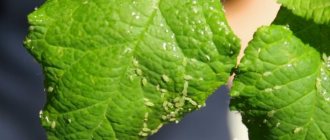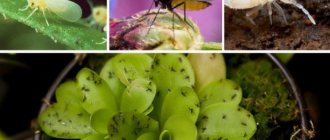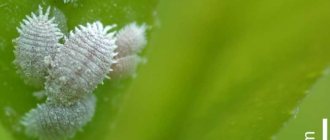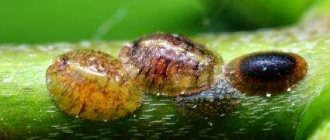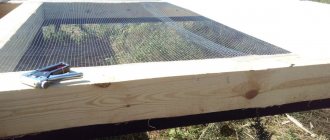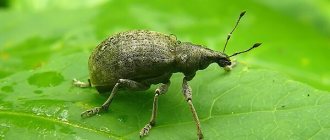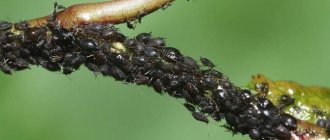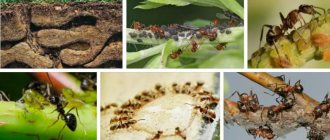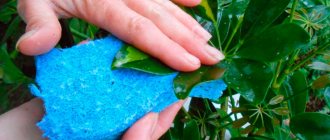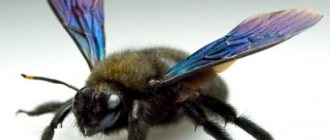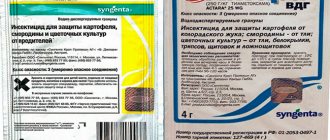Curling leaves, wilting buds, and the plant losing its attractiveness are the first signs of pests. To save the beauty on the windowsill, you need to know how to get rid of aphids on indoor flowers and prevent their appearance in the future. When fighting parasites, it is important to identify and eliminate the causes of the problem, and then destroy the pests using folk remedies or insecticides.
Aphids are a dangerous parasite that quickly adapts to any conditions and in a short time creates large colonies that destroy indoor plants. To save your home greenhouse, it is important to start pest control in a timely manner.
The article contains relevant and effective methods of combating aphids that will help save the plant and restore its attractiveness and vitality.
Description of aphids and how they appear in the house
Aphids are small insects with long legs and a pointed abdomen. The oblong body can be yellow, green, black or pink, but white pests are most often found on indoor plants.
One female aphid can lay up to 100 eggs at a time, which in a couple of weeks turn into adults that destroy flowers. Parasites use their proboscis to suck out the juice from the stems and leaves, depriving the plant of its vitality and attractiveness. In addition, they often spread viral and fungal diseases (sooty fungus). If the necessary measures are not taken in a timely manner, pests quickly adapt to any habitat and form numerous colonies that can destroy all the beauty on the windowsill.
Aphids attack different types of plants, but hyacinths, chrysanthemums, hibiscus, orchids, fuchsias and cyclamens are especially susceptible to attack by pests.
Where can pests appear in the house:
- through open windows and a balcony in the absence of mosquito nets;
- with new flowers (cut or in pots);
- from a person's clothing;
- through the soil used for transplantation;
- The carriers of the larvae can be ants that breed aphids for their own food.
To avoid the spread of aphids from a newly purchased plant to your home ones, keep it in quarantine for several days, and also carry out preventive treatment with special insecticides.
The main reason for the appearance of aphids is dried soil and high indoor temperatures.
Who is the white or root aphid?
Root aphids are one of the types of pests that can most often be found at or slightly above the soil line, since their life cycle is associated with this environment. Since this species also feeds mainly in the root part of the plant, which is poor in chlorophyll, the body color of the pest is predominantly white, although in some cases it can turn into green shades.
Root aphids are quite a strong pest, especially among indoor plants, since they are most easily introduced with soil, and the feeding process occurs at the very root. If the ordinary green aphid destroys those parts of the plant that are located at or above the level of its largest population, then the white aphid spoils the base of the stem, thereby disrupting the normal processes of growth and nutrition of the entire plant.
In addition, white aphids are much more difficult to detect, unlike small colonies of green and other aphids that can be found “live” on stems and leaves. Root aphids hide in the soil more successfully, reproduce more prolificly and move much faster. As a result, her colonies will be virtually invisible, despite the fact that her colonies will suck up enough of the plant's sap that the plant will begin to show irreversible changes and even die before the cause becomes clear.
Upon close inspection of the plant, you will often find a white, waxy material secreted by root aphids. There is especially a lot of this peculiar honeydew at the base of the stem and the first few millimeters of the root down from the soil line.
If a living individual catches your eye, you can note the following external characteristics - the body of the insect is more pear-shaped than that of green aphids, but somewhat smaller, and the insects themselves move more actively. Many people confuse white aphids with mealybugs, and for good reason, because they have quite a lot in common, but the latter have a more oval-shaped body. Root aphids are about the same size or slightly smaller than green aphids, but have shorter legs and antennae. Also, an interesting fact is that this type of pest comes in a variety of colors, including pink, but they are mostly white and brown.
Besides mealybugs, due to their unusual color and winged stage, white aphids are often confused with fungus gnats. The main differences in this are the characteristics that all aphids have - a small tail extension at the end of the abdominal cavity, which also distinguishes them from mealybugs.
Because of their size and habitat below the soil line, root aphids can go undetected, even after one or even several complete biological cycles. In addition, their damage is often mistaken for other problems, especially nutritional deficiencies. Such traces of insect activity are similar to magnesium or iron deficiency, so when such signs appear, flower pots should be carefully checked for the presence of root aphids.
House flowers are not the only hosts of root aphids. There are also quite a lot of them in open ground, where the pest activity of insects is traditionally accompanied by the activity of ants and similar signs of plant damage.
Signs of pests on flowers
Aphids can cause significant damage to plants, so it is important to begin combating the parasites as early as possible. To do this, you need to know the signs of pests in your home greenhouse and periodically inspect each indoor flower for symptoms of disease.
The first manifestations of aphid infestation:
- a sticky layer and tiny punctures appear on the leaves and young shoots;
- flower buds quickly fade and fall off before they have time to bloom;
- the flower loses its attractiveness, withers and dries out;
- leaves darken and curl;
- Ants appear on the windowsill, attracted by the waste products of aphids, which are used by insects as food.
One of the signs of plant infestation by aphids is the appearance of ants. Insects feed on honeydew secreted by parasites, so they are always close to them and can even independently introduce pests to flowers
Damage from activity
Damage from root aphids usually manifests itself as severe "weakness" of the plants. Withered, curled yellow leaves, which resemble signs of nutrient deficiency, appear in various places on the stem, stop growing and fall off. The fruits and flowers on such plants will be small, stunted, and, as a rule, will fall off before reaching their maximum stage of development. Also, as already noted, attacks by root aphids can leave plants vulnerable to various adverse environmental conditions - root rot, mold and disease.
Visible symptoms such as yellowing of leaves often lead to consideration of adding some nutrients to the soil, usually magnesium, but this often fails.
As additional information, it can be noted that root aphids, in addition to indoor, greenhouse and garden perennial plants, affect rice crops, the roots of various trees, including spruce and walnut. White aphids can also cause damage to meadow perennial grasses if their standard hosts are not observed in their distribution area.
Folk remedies and methods of combating aphids
You can remove aphids from indoor plants yourself using available means. Such methods are easy to use, affordable and absolutely safe for healthy flora, people and pets.
Algorithm for saving indoor plants:
- Isolation of a sick flower, which will protect the rest from infection.
- Preventive spraying of healthy flora.
- Treatment of the affected flower using the chosen method.
Folk remedies for fighting aphids are presented in the table:
| Active substance | Procedure for preparing the composition | Mode of application |
| Celandine | Grind 150 g of dried raw materials or 350 g of fresh herbs and add 1 liter of water. Leave the product in the dark for 24 hours | Spray the plant with the resulting infusion three times at intervals of a day. |
| Wood ash | Mix 50 g of soap, 0.5 l of ash and 10 l of water | Treat the affected leaves and shoots with a filtered solution until the pests are completely destroyed. |
| Garlic | Grind 30 g of garlic in a blender, add 1 liter of water and leave to brew for a day in a dark place. | Treat the flowers with the resulting product three times at intervals of 5 days. |
| Tomato tops | Grind 500 g of raw material, add 1 liter of water and boil for 30 minutes. Add 4 g of liquid soap to the cooled broth | Treat the affected plant until complete recovery. |
| Tobacco | Combine raw materials and water in a 1:2 ratio and let it brew for 2 days. | Dilute the resulting infusion with water and spray the flower. Avoid contact with the soil to avoid damage to the root system. |
| Hot pepper | Grind 50 g of pepper and add 125 ml of water. Boil the mixture for an hour and let it brew for a day | Dilute the filtered infusion in 10 liters of water, use for spraying and watering flowers |
| Orange peels | Pour 100 g of citrus peel with water and let it brew for a couple of days in a warm place | Spray plants affected by aphids |
| Needles | Pour 500 g of pine needles into 2 liters of water and leave for a week, then strain and dilute with water in a ratio of 1:7 | Treat the flower several times with a break of 4 days |
Geranium, dill, parsley, mint or marigold will help fight aphids. Parasites cannot stand the aromas of these plants, so by placing a pot with one of them on the windowsill, you can not only get rid of pests, but also avoid their appearance in the future.
Ladybugs can be used as a biological method of controlling aphids, so do not drive out an insect that has settled on an indoor flower
Useful recommendations and prevention
To prevent the appearance of insects, follow the recommendations:
- When aphids appear, immediately take measures to get rid of them;
- treat the area and seeds before planting;
- do not fertilize tomatoes with nitrogen in large quantities, as it attracts pests;
- in the fall, burn all plant remains in order to destroy it in case of disease.
By adhering to these rules, it is easy to avoid the appearance of insects.
Video: Folk remedy for fighting aphids on tomatoes
Thus, there are many types of aphids that spread quickly on tomatoes, so it is recommended to take action when you notice the first signs of infestation. To do this, they use chemical, physical and folk methods, which we described above. By choosing the right one, you will protect the plants on the site from such troubles.
Mechanical methods of getting rid of pests
You can save indoor flowers using mechanical cleaning, but this method is effective only at the initial stage of infection. To preserve the plant, remove damaged leaves, buds and shoots and wash it daily under running water. A solution of laundry soap will help to achieve maximum effect. Processing procedure:
- Prepare a soap solution from laundry soap and water in a ratio of 1:6.
- Prepare the necessary attributes, put on rubber gloves.
- Soak a sponge in the solution and thoroughly wipe all leaves, shoots and stems. Avoid getting the product on the soil.
- Rinse the plant with clean running water.
- Repeat the treatment daily until the parasites are completely eliminated.
To mechanically remove aphids, wipe the leaves daily with a damp sponge, remove affected shoots and bathe the flowers under running water.
As an alternative to soap solution, you can use medical alcohol - dissolve 6 tbsp in 1 liter of water. spoons of the product and wipe all the leaves. This composition effectively removes pests and does not damage the leaves, since ammonia quickly evaporates from the surface.
To be sure to get rid of aphids, replace the top part of the soil, where eggs and larvae of pests may be. In this case, choose high-quality soil that has been disinfected or frozen.
Where, where and why does it appear?
Surprisingly, even a single female that settles on flowers can independently reproduce thousands of small copies. White aphids reproduce fantastically quickly.
Aphids cannot get into the house on their own. The pest was brought from the street:
- along with flowers;
- greens;
- soil;
- purchased plants that have already been affected;
- on shoes;
- on animal fur.
The garden or vegetable garden has the most favorable conditions for the reproduction of aphids. An insect can move from area to area with the help of ants. They carry aphids on themselves because they feed on the sweet secretion secreted by arthropods (read about the symbiosis of ants and aphids here).
White aphids love flowers very much:
Insects can fly in through an open window or door. This is especially true for wild crops located on a terrace or balcony.
More details about the habitats of aphids and the reasons for their appearance are described in a separate article.
Chemicals for killing parasites
If folk remedies are ineffective, use chemicals. The choice of means depends on the degree of damage and the scale of the disaster. The most effective means include: “Decis”, “Iskra”, “Fitoverm”, “Aktellik”, “Confidor”, “Akarin”, “Karate”.
Spraying flowers with chemicals will help get rid of aphids. When working with insecticides, observe safety precautions and strictly follow the instructions for the product.
Procedure for using chemicals:
- Read the instructions for use of the product.
- Take the recommended safety measures - put on seals and a respirator, remove pets and children from the premises. After handling, wash your hands thoroughly with a concentrated soap solution.
- Wipe the leaves and stems with a sponge soaked in soapy water and then let dry.
- Spray the flower. Carry out the treatment on the balcony on a cloudy day at a temperature of +21…25 ℃, since at a lower temperature the effectiveness of the drug decreases.
- Perform preventive spraying of all plants in the house to prevent aphids from moving onto them.
- Re-treat the flowers several times at intervals of 5-7 days (depending on the recommendations in the instructions).
If the plant cannot be saved, discard it to avoid contaminating other flowers.
Signs of aphids
Aphids are very small insects. It is not always possible to notice a single individual.
Therefore, there are a number of signs of attack by these insects:
- a large number of insects in the lower part of the plant;
- curling of the leaf and flower (due to the lack of a sufficient amount of juice that the aphid drank);
- sticky mucus, which is also called honeydew, containing sugar (therefore, ants, because of their love for sweets, “protect” aphids);
- cessation of tomato growth and rotting.
It is necessary to pay attention to the development of the tomato: if it has yellowed leaves and is growing slowly, this may be a sign of aphid damage.
Prevention of aphids
Proper plant care and compliance with the recommended preventive measures will help to avoid the appearance of aphids:
- periodically carry out preventive treatment of plants;
- Make sure to maintain the optimal temperature in the house, as insects settle in a stuffy, poorly ventilated room;
- keep new flowers in quarantine;
- install mosquito nets on all windows in the apartment;
- do not place bouquets of cut flowers (especially chrysanthemums and roses) near indoor plants;
- Soak the new soil for replanting in the cold for several days to destroy the larvae and eggs of pests.
To preserve indoor flowers, provide them with proper care, regularly inspect them to identify pests in a timely manner, and periodically carry out preventive treatment
Maintaining a favorable microclimate in the house, proper care of plants and compliance with preventive measures will help save indoor flowers from aphids. If you were unable to protect them from pests, start fighting when parasites are first detected, preventing the colony from growing. Mechanical treatment, folk remedies and chemicals can help in exterminating insects. The choice of control method depends on the scale of the disaster and individual preferences.
What types of aphids eat tomatoes?
Aphids differ in external characteristics and in the structure of the body, so it is recommended to know which particular variety appeared on the plants and what features it has.
Black
Black garden aphids are divided into the following types:
Externally, the insects are about 0.5 cm in length, with a flat oval-shaped body and many legs.
White
The white aphid has a drop-shaped appearance and is also white in color, which is why it is sometimes compared to drops of morning dew. If you look closely, you can see the typical structure for this species: proboscis, antennae, many legs. The body is translucent, can be with or without wings. Also, this type is called root.
Peach
The peculiarity of this species is its small size compared to others, up to 2.5 mm in length. The body is oval, there is a trunk and antennae. The color is rich, peach, but a little transparent, sometimes it can be pinkish, the eye color is brown. Females can be either winged or wingless.
Bakhchevaya
It has several shades: from yellow to transparent green. It is also called cotton. These are the smallest insects of their species, reaching a size of up to 1.8 mm. They act as carriers of about 50 viruses.
Tips and preventive measures
To prevent damage to indoor orchids by aphids and other pests, you need to adhere to a number of preventive measures :
- In order for your orchid to please you for a long time, water it at certain hours and regularly, once a week. In winter and autumn you should water the flower less often than in summer;
- Do not allow the soil to dry out;
- Spray periodically, but pay attention that water does not collect on the leaves and in the flower bud;
Don't forget to spray your orchid periodically. - Remember to constantly check the flower, especially the underside of the leaf;
- It is advisable to keep the flower that first entered your home separately from the rest for a week and regularly check for the presence of harmful insects;
- Maintain the orchid's fertilization system strictly . An excess or deficiency of elements such as iron or nitrogen greatly weakens plant immunity. Weakened orchids are an excellent target for aphids;
- When replanting, use only disinfected pots.
Attention! If during a routine examination you find white scales on the underside of the flower, this means that your flower is infested with aphids. Young individuals molt several times as they grow, leaving scales on the surface of the leaves.
Spread, entering the plant
Aphids can attack a beautiful orchid in many ways, for example :
- Through the open window;
- Can move from other indoor flowers;
- From the clothes and shoes you wore down the street.
It can move into your home along with a flower from the store and the soil.
Aphids on orchids begin to take root :
- From the inside of the sheet;
- And on young shoots.
Then, having multiplied, they go to the stem and get to the juiciest place - the flower bud . Also, these small insects appear if the plant is placed in a too dry and unventilated room.
Important! When purchasing an orchid at a retail outlet, you must inspect it very carefully for the presence of pests. It is necessary to inspect not only the above-ground part of the plant, but also the soil in the pot.
